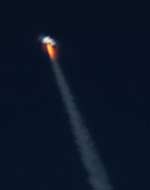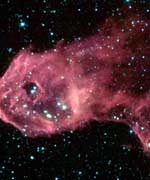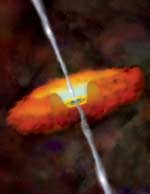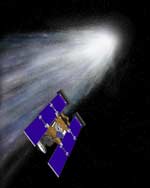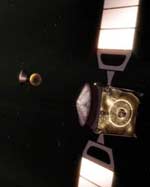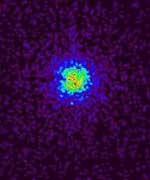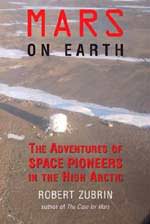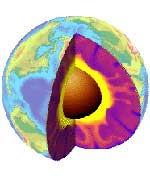
Image credit: NASA
Geologists at the University of Berkeley believe that radioactive potassium might be a substantial source of heat in the Earth’s core. The problem has been that scientists haven’t found as much potassium in the Earth’s crust as they would have expected from the Earth’s early bombardment period by asteroids. However, the geologists discovered that potassium can form a heavy alloy with iron under high temperatures and pressures, so it might have just sunk to the middle of the Earth, and could form a minute component of the core – but a fifth of its heat.
Radioactive potassium, common enough on Earth to make potassium-rich bananas one of the “hottest” foods around, appears also to be a substantial source of heat in the core of Earth, according to recent experiments by University of California, Berkeley, geophysicists.
Radioactive potassium, uranium and thorium are thought to be the three main sources of heat in the Earth’s interior, aside from that generated by the formation of the planet. Together, the heat keeps the mantle actively churning and the core generating a protective magnetic field.
But geophysicists have found much less potassium in the Earth’s crust and mantle than would be expected based on the composition of rocky meteors that supposedly formed the Earth. If, as some have proposed, the missing potassium resides in the Earth’s iron core, how did an element as light as potassium get there, especially since iron and potassium don’t mix?
Kanani Lee, who recently earned her Ph.D. from UC Berkeley, and UC Berkeley professor of earth and planetary science Raymond Jeanloz have discovered a possible answer. They’ve shown that at the high pressures and temperatures in the Earth’s interior, potassium can form an alloy with iron never before observed. During the planet’s formation, this potassium-iron alloy could have sunk to the core, depleting potassium in the overlying mantle and crust and providing a radioactive potassium heat source in addition to that supplied by uranium and thorium in the core.
Lee created the new alloy by squeezing iron and potassium between the tips of two diamonds to temperatures and pressures characteristic of 600-700 kilometers below the surface – 2,500 degrees Celsius and nearly 4 million pounds per square inch, or a quarter of a million times atmospheric pressure.
“Our new findings indicate that the core may contain as much as 1,200 parts per million potassium -just over one tenth of one percent,” Lee said. “This amount may seem small, and is comparable to the concentration of radioactive potassium naturally present in bananas. Combined over the entire mass of the Earth’s core, however, it can be enough to provide one-fifth of the heat given off by the Earth.”
Lee and Jeanloz will report their findings on Dec. 10, at the American Geophysical Union meeting in San Francisco, and in an article accepted for publication in Geophysical Research Letters.
“With one experiment, Lee and Jeanloz demonstrated that potassium may be an important heat source for the geodynamo, provided a way out of some troublesome aspects of the core’s thermal evolution, and further demonstrated that modern computational mineral physics not only complements experimental work, but that it can provide guidance to fruitful experimental explorations,” said Mark Bukowinski, professor of earth and planetary science at UC Berkeley, who predicted the unusual alloy in the mid-1970s.
Geophysicist Bruce Buffett of the University of Chicago cautions that more experiments need to be done to show that iron can actually pull potassium away from the silicate rocks that dominate in the Earth’s mantle.
“They proved it would be possible to dissolve potassium into liquid iron,” Buffet said. “Modelers need heat, so this is one source, because the radiogenic isotope of potassium can produce heat and that can help power convection in the core and drive the magnetic field. They proved it could go in. What’s important is how much is pulled out of the silicate. There’s still work to be done ”
If a significant amount of potassium does reside in the Earth’s core, this would clear up a lingering question – why the ratio of potassium to uranium in stony meteorites (chondrites), which presumably coalesced to form the Earth, is eight times greater than the observed ratio in the Earth’s crust. Though some geologists have asserted that the missing potassium resides in the core, there was no mechanism by which it could have reached the core. Other elements like oxygen and carbon form compounds or alloys with iron and presumably were dragged down by iron as it sank to the core. But at normal temperature and pressure, potassium does not associate with iron.
Others have argued that the missing potassium boiled away during the early, molten stage of Earth’s evolution.
The demonstration by Lee and Jeanloz that potassium can dissolve in iron to form an alloy provides an explanation for the missing potassium.
“Early in Earth’s history, the interior temperature and pressure would not have been high enough to make this alloy,” Lee said. “But as more and more meteorites piled on, the pressure and temperature would have increased to the point where this alloy could form.”
The existence of this high-pressure alloy was predicted by Bukowinski in the mid-1970s. Using quantum mechanical arguments, he suggested that high pressure would squeeze potassium’s lone outer electron into a lower shell, making the atom resemble iron and thus more likely to alloy with iron.
More recent quantum mechanical calculations using improved techniques, conducted with Gerd Steinle-Neumann at the Universit?t Bayreuth’s Bayerisches Geoinstit?t, confirmed the new experimental measurements.
“This really replicates and verifies the earlier calculations 26 years ago and provides a physical explanation for our experimental results,” Jeanloz said.
The Earth is thought to have formed from the collision of many rocky asteroids, perhaps hundreds of kilometers in diameter, in the early solar system. As the proto-Earth gradually bulked up, continuing asteroid collisions and gravitational collapse kept the planet molten. Heavier elements ? in particular iron – would have sunk to the core in 10 to 100 million years’ time, carrying with it other elements that bind to iron.
Gradually, however, the Earth would have cooled off and become a dead rocky globe with a cold iron ball at the core if not for the continued release of heat by the decay of radioactive elements like potassium-40, uranium-238 and thorium-232, which have half-lives of 1.25 billion, 4 billion and 14 billion years, respectively. About one in every thousand potassium atoms is radioactive.
The heat generated in the core turns the iron into a convecting dynamo that maintains a magnetic field strong enough to shield the planet from the solar wind. This heat leaks out into the mantle, causing convection in the rock that moves crustal plates and fuels volcanoes.
Balancing the heat generated in the core with the known concentrations of radiogenic isotopes has been difficult, however, and the missing potassium has been a big part of the problem. One researcher proposed earlier this year that sulfur could help potassium associate with iron and provide a means by which potassium could reach the core.
The experiment by Lee and Jeanloz shows that sulfur is not necessary. Lee combined pure iron and pure potassium in a diamond anvil cell and squeezed the small sample to 26 gigapascals of pressure while heating the sample with a laser above 2,500 Kelvin (4,000 degrees Fahrenheit), which is above the melting points of both potassium and iron. She conducted this experiment six times in the high-intensity X-ray beams of two different accelerators – Lawrence Berkeley National Laboratory’s Advanced Light Source and the Stanford Synchrotron Radiation Laboratory – to obtain X-ray diffraction images of the samples’ internal structure. The images confirmed that potassium and iron had mixed evenly to form an alloy, much as iron and carbon mix to form steel alloy.
In the theoretical magma ocean of a proto-Earth, the pressure at a depth of 400-1,000 kilometers (270-670 miles) would be between 15 and 35 gigapascals and the temperature would be 2,200-3,000 Kelvin, Jeanloz said.
“At these temperatures and pressures, the underlying physics changes and the electron density shifts, making potassium look more like iron,” Jeanloz said. “At high pressure, the periodic table looks totally different.”
“The work by Lee and Jeanloz provides the first proof that potassium is indeed miscible in iron at high pressures and, perhaps as significantly, it further vindicates the computational physics that underlies the original prediction,” Bukowinski said. “If it can be further demonstrated that potassium would enter iron in significant amounts in the presence of silicate minerals, conditions representative of likely core formation processes, then potassium could provide the extra heat needed to explain why the Earth’s inner core hasn’t frozen to as large a size as the thermal history of the core suggests it should.”
Jeanloz is excited by the fact that theoretical calculations are now not only explaining experimental findings at high pressure, but also predicting structures.
“We need theorists to identify interesting problems, not only check our results after the experiment,” he said. “That’s happening now. In the past half a dozen years, theorists have been making predictions that experimentalists are willing to spend a few years to demonstrate.”
The work was funded by the National Science Foundation and the Department of Energy.
Original Source: University of Berkeley News Release
